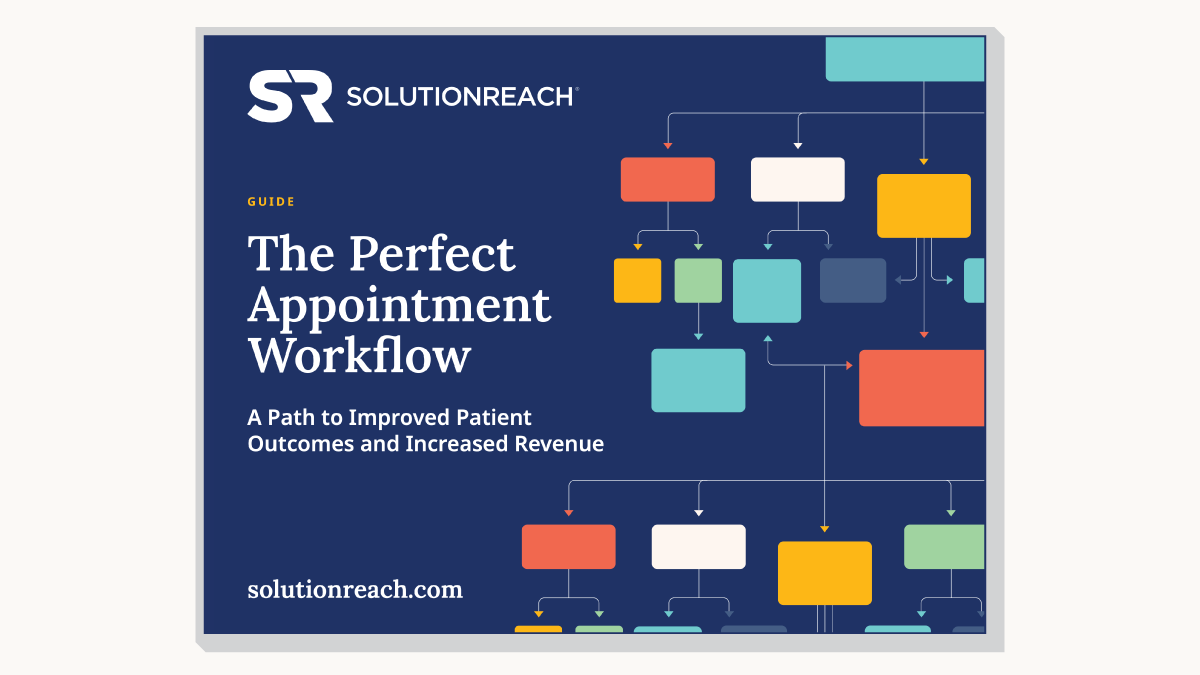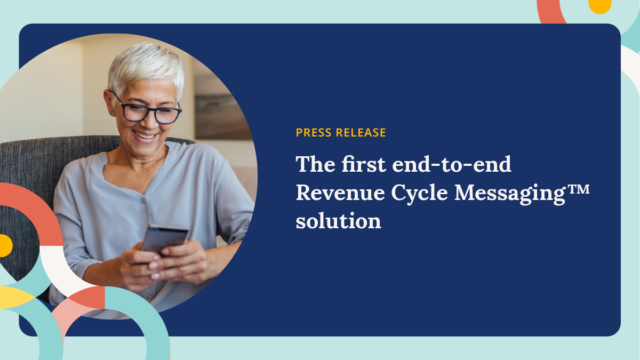The Perfect Appointment Workflow:
A Path to Improved Patient Outcomes and Increased Revenue
Though the future is beginning to look brighter on the COVID front thanks to the ongoing vaccine rollout and declining case numbers, the pandemic has taken a heavy toll on healthcare organizations. From patients deferring care, to curtailed office hours and temporary closures, to lost revenue and reimbursements, providers are reeling from the impact of the virus. Now, they’re trying to recover and figure out how to climb back to pre-COVID levels of operation and revenue.
Roughly 87 percent of healthcare leaders said safety was patients’ top reason for not scheduling care visits during the pandemic. Along with significant drops in patient volume, a study by the American Medical Association reported that the average revenue loss for providers was more than 30 percent. Other research suggested that one in five healthcare organizations saw revenue plummet by 50 percent.
Add to that the fact that patients’ communication preferences have changed during COVID while no-shows and late cancellations continue to plague providers, and it’s plain to see that the current appointment workflow isn’t working. In the last couple of years there’s been a growing communication gap between patients and their providers:
- Patient satisfaction with healthcare communication fell seven percent.
- Patients’ desire for phone calls dropped 14 percent.
- 79 percent of patients want to receive text messages from their provider.
- 73 percent of patients want to be able to send texts to their provider.
We live in a world where patients’ expectations continue to evolve and their preferred way to interact with providers today is by texting. But that’s clearly incompatible with current appointment workflows that rely heavily on time-consuming and resource-draining manual phone calls to reach patients. In the end, this shift means that providers aren’t meeting patients where they are, which diminishes patients’ ability to get the care they need when they need it. One in three patients said they would consider switching providers because of logistical issues, including communication.
What providers lack is a text-first patient communication approach that emphasizes a fast, accessible, and results-driven system to minimize disruptions and ensure patients arrive on time and prepared for appointments.
Disruptions and a Broken Workflow
In healthcare, disruptions are an inevitable part of the multifaceted logistics of scheduling and treating patients. Whether these everyday interruptions are patient-driven, internal issues, or “acts of God”—even before COVID entered the scene—they inevitably snowball into costly setbacks for providers. Most often, they come in the form of people not showing up for their appointments, late cancellations, and patients arriving late and unprepared for their visits. It’s no secret that the average no-show rate is 10 to 30 percent, which translates into annual revenue losses of $150,000 to $300,000 per provider.
But disruptions also come in other ways that directly impact your business. Sixty-two percent of providers agree that non-adherent patients affect quality metrics, which means providers take a hit on reimbursements. As touched on previously, lowered patient satisfaction stemming from communication incompatibilities can affect loyalty that also dips into a provider’s bottom line.
That’s why stopping the bleeding is paramount. By establishing better lines of communications with patients and achieving greater efficiencies in the appointment workflow, providers can minimize and mitigate many of these hitches to profitable enterprise.
However, the existing appointment workflow isn’t working primarily for two reasons—patient communication preferences have changed and technology has advanced. For example, consumer-friendly technologies like texting have raised the bar for people’s communication expectations. People use texting for restaurant reservations, to book hotel rooms, and rent cars. Shouldn’t patients also be able to use texting for something as important as their healthcare?
But in many instances, patients and providers simply aren’t speaking the same language when it comes to healthcare conversations. The result is that current appointment interactions are limited, less effective, and often painful—for patients and providers.
- Phones: For patients, texting from smartphones is fast, convenient, and comfortable, yet providers are still trying to set up appointments by phone. The response rate for text messages is 209 percent higher than it is for phone calls. The average time it takes to book an appointment by phone is eight minutes while it takes only four seconds to send a text message. When voice message appointment reminders go unanswered or patients get put on hold, the outcome is fewer confirmations and higher no-show rates. It also leads to lowered patient satisfaction due to the hassle and frustration patients experience from playing phone tag with providers. Clearly, phone calls are an ineffective way to reach patients and expend valuable staff resources that could be better used elsewhere.
- EHRs and Patient Portals: Reliance on electronic health records (EHR) and patient portals as an appointment reminder tool is also problematic and contributes to hiccups and delays in the appointment workflow. EHRs aren’t designed for efficient patient communication while patient portals can be difficult to use and only nine percent of patients actually use portals. Just connecting with patients through these tools is challenging and sending appointment messages through them is largely futile.
- Basic reminder systems: Simple appointment reminder solutions can send a single text reminder, however they’re extremely limited in their capabilities. These systems don’t have the ability to send a series of reminders, typically have caps on the quantity of text messages that can be sent, and don’t offer the flexibility to communicate with groups of patients for unexpected events and schedule disruptions. They’re also not user-friendly for staff, making them difficult to self-service and deliver time-sensitive patient communications.
- Multiple workflows: Though the introduction of telehealth during COVID has been a boon to providers, many organizations use separate and distinct appointment workflows for in-person versus virtual care visits. This duality creates extra work for staff, is inefficient, and is confusing for patients.
Healthcare organizations need a method to communicate with patients that is quick, effective, and that meets patients’ communication preferences without overly taxing staff resources. Providers want an appointment workflow that works for them rather than against them through which they can connect with patients at every point of their healthcare journey. Establishing clear, more personal communication better positions providers to ensure that schedules are filled and patients arrive on time and ready to go.
Hold the Phone
Today’s patients are busy, juggling multiple responsibilities, often working from home, and they don’t have time to wait on hold or play other telephone games with providers.
- Sixty percent of patients say they won’t wait on hold for more than one minute before hanging up.
- One-third of those who hang up won’t call back.
- Thirty-six percent of patients said being placed on hold is a huge time waster.
- Forty-nine percent of patients get phone call reminders, but only 18 percent want them.
Redefining the Appointment Workflow
In order to sidestep the many pitfalls involved in modern patient communications, a more engaging appointment workflow requires a text-first approach that meets patients at each phase of the appointment journey. Eighty-six percent of providers said that text messaging improved patient experience and 81 percent said text messaging improved patient outcomes.
At every step, from scheduling and confirming the appointment to the visit itself, and to follow-up instructions and reminders, providers need to reimagine care as an ongoing progression rather than as individual events. Efficiency and success will be driven by:
- Automated communication
- Group messaging
- Two-way text messaging
Through automated text reminders and instructions, providers can connect simultaneously with multiple patients based on their individual communication preferences. Automation allows providers to reach patients by casting a wider net while reducing the amount of time staff spend making phone calls. During the pandemic, patients’ desire for automated communications across the patient journey increased to 84 percent. Automated text messages are a speedy and effective way to communicate:
- Appointment reminders
- Pre-visit instructions
- Patient intake
- Surveys
- Recall reminders
- Portal adoption
- Education
To achieve the flexibility to reach groups of patients or all patients at once, group messaging is a vital component of a more refined appointment workflow. Whether it’s a health emergency, a weather emergency, or an effort to promote preventive care like flu shots or the COVID vaccine, group messaging helps providers reach large numbers of patients at the click of a mouse. Manually attempting to reach patients by phone under such circumstances is impractical and a costly drain on staff resources.
The final piece of the puzzle in a redefined appointment workflow is providers’ ability for two-way text message communication with their patients. Again, the vast majority of patients today want the ability to text their provider directly to ask questions and quickly get answers. Real-time, two-way text messaging enables pre-screening questions, “park & wait” communications, and serves as a valuable tool to remind patients to schedule follow-up care. A text-first mindset is central to a provider’s appointment workflow and creating an end-to-end communication loop that engages patients throughout their journey.
The Perfect Appointment Workflow
To connect more effectively with patients throughout the appointment experience, providers need to communicate with patients during five main stages—schedule, prepare, same-day, visit, and follow-up. Each touchpoint guides and supports patients at crucial points before, during, and after the care visit.
The perfect appointment workflow, maintained by an automated, text-first communication strategy, helps patients keep their appointments and to show up on time and prepared. When patients are well-informed and communication is more effortless, they’ll not only get the care they need but adherence and satisfaction levels will also increase.
A streamlined appointment workflow supports both virtual and in-person appointments while clearer and more user-friendly communication allows providers to form stronger relationships with their patients. The implementation of a perfect appointment workflow can improve patient outcomes even as it reduces staff time spent on phones and increases provider revenue and reimbursements.



